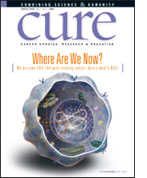Publication
Article
CURE
Hak Choy: The Combined Approach
Author(s):
Radiation oncologist Hak Choy, MD, became a leader in the cancer field when he began looking for ways to combine radiation, chemotherapy, and targeted agents against cancer.
Hak Choy
MD
Dallas
While the field of radiation has certainly seen many exciting advances in the past decade, experts like , , chair of radiation oncology at the University of Texas Southwestern Medical Center at , look forward to even more innovations on the horizon. Most of the coming changes, he says, involve combining new technology with other therapies.
“A cancer is made up of very heterogeneous tumor cell population, which often makes it difficult to eradicate with one drug or modality,” Choy says. “So we need to use agents or modalities that have synergistic effects.”
In the past, radiation therapy was the main modality to treat lung cancer, Choy’s specialty. Later, physicians combined chemotherapy with radiation therapy, which requires close collaboration between medical oncologists and radiation oncologists.
Choy is a leader in looking for ways to use chemotherapy and radiation, along with biological therapies, in a discerning way that helps physicians outwit the cancer. In some cases, cancer cells have the ability to repair themselves after chemotherapy. Others can’t survive chemotherapy, but are less vulnerable to radiation.
“Radiation works on different cell populations,” Choy explains. “Some cells are more resistant, some are more susceptible to radiation.”
University
California
Los Angeles
Cells that are hypoxic (have a shortage of oxygen) are more resistant to radiation, Choy says, and some cancer cells develop resistance to radiation therapy over time. Others are just intrinsically resistant, he adds. A study from the of , showed 46 percent of breast cancer stem cells survived radiation treatment compared with 20 percent of normal breast cancer cells. The UCLA researchers suggested radiation may activate a signaling pathway that alerts the cancer stem cells to start repairing themselves.
If oncologists can better coordinate their efforts so that chemotherapy and radiation shut down the cancer cells with a synergistic effect, Choy believes they can make an impact on cancer cells’ ability to survive.
An exciting example of this synergy is the monoclonal antibody Erbitux (cetuximab) combined with radiation therapy. While effective on its own as an epidermal growth factor receptor inhibitor, studies show Erbitux makes cancer cells less likely to recover after radiation. It has been especially helpful in lung and head and neck cancers. Choy’s research has looked at targeted therapies, such as Erbitux, as a potential treatment for non-small cell lung cancer.
Success in fighting the cancer war depends on how well we kill the cancer cells while minimizing the [side effects]," Choy says. "I believe the comination of radiation, chemotherapy, and biological therapy will maximize the chance we'll win."






